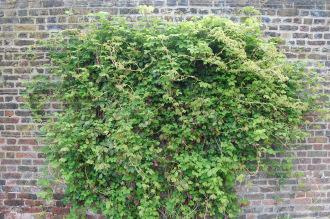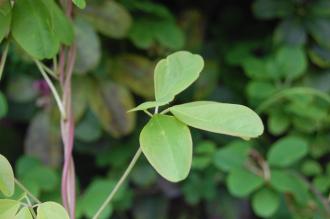
Akebia quinata (23/04/2016, Kew Gardens, London)
Position: Full sun to partial shade
Flowering period: Spring
Soil: Moist, well drained
Eventual Height: 10m
Eventual Spread: 4m
Hardiness: 4b, 5a, 5b, 6a, 6b, 7a, 7b, 8a, 8b, 9a
Family: Lardizabalaceae
Akebia quinata is a fast growing woody semi evergreen climber with a twining habit. Its bright green leaves are composed of five leaflets. Each leaflet is obovate with entire margins, up to 5cm long and 2.5cm across. Its red/ purple monoecious fragrant flowers appear as racemes and are not self fertile. Its purple fruits are ovoid, up to 8cm long, 4cm broad, appear in autumn and split open to reveal fleshy pulp.

Akebia quinata Flower (23/04/2016, Kew Gardens, London)
Akebia quinata, commonly known as Chocolate Vine or Five Leaf Akebia, is native to China, Japan and Korea. In its native habitat it grows at forest margins, near streams and in scrub. This plant is prohibited from sale and commercial propagation in New Zealand.
The etymological root of the binomial name Akebia is derived from the Japanese Akebi, the name for this plant. Quinata is derived from the Latin quinque meaning ‘five’.
he landscape architect may find Akebia quinata useful as a wall or trellis trained climber, it requires climbing supports.
Ecologically, Akebia quinata flowers are attractive to pollinating insects. Its fruit are attractive to some birds and mammals.

Akebia quinata Leaf (23/04/2016, Kew Gardens, London)
The Royal Horticultural Society have given the variety Akebia quinata ‘White Chocolate’ their prestigious Award of Garden Merit in 2012.
Akebia quinata prefers moist, fertile, humus rich, well-drained soils. It tolerates most pH of soil.
Akebia quinata requires little maintenance. Pruning, if necessary, should be carried out after flowering.

Landscape Architecture

